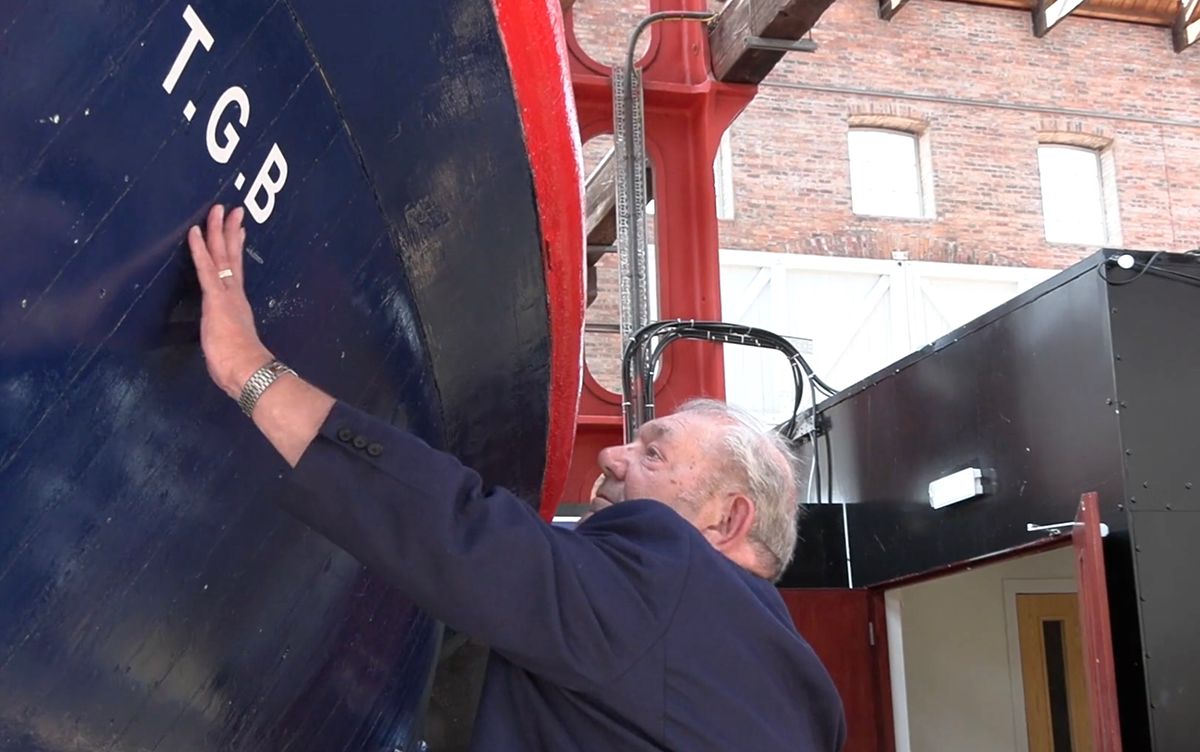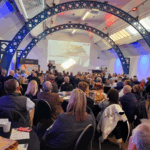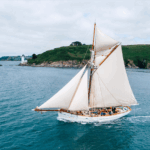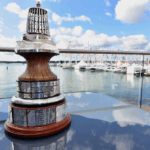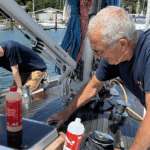A moving new short film capturing the emotional reunion between a fisherman and the lifeboat which saved him and his 14 crewmates in the treacherous Pentland Firth nearly 60 years ago, is now on show at the Scottish Maritime Museum on Irvine Harbourside.
The 20-minute film follows 83-year-old Dennis Avery as he touches the RNLI lifeboat TGB one final time and pays tribute to the lifeboat crew who came to the rescue of the Grimsby trawler Ross Puma in April 1968.
The dramatic rescue was TGB’s final mission before the lifeboat and all eight crew members were lost in the Longhope Lifeboat Disaster less than a year later.
Dennis’ visit was made possible through a new partnership between the Scottish Maritime Museum and the Grimsby Fishing Heritage Centre. Dennis now works at the Centre as a tour guide on the Ross Tiger, Ross Puma’s sister ship and the UK’s oldest surviving diesel side-trawler.
In the film, Dennis, who is now the last surviving member of the Ross Puma crew, recalls the terrifying night when the Ross Puma, heading home laden with fish, was struck by a violent snowstorm in the Pentland Firth, one of the world’s most treacherous sea passages.
With radar down, visibility near zero and battered by thirty foot waves, the trawler ran aground on the jagged North Rackwick Shoals off Hoy, Orkney.
Dennis, then 26 years old and the Ship’s Mate, remembers being “half thrown out, half jumping out” of his bunk at 2.30am as he heard the ship “tearing itself apart on the rocks” and believing he was about to die. Reaching the deck, barefoot in the snow, he recalls rallying the crew to prepare for rescue and, when one young crew member fears drowning, reassuring him saying: “we can’t possibly drown, we’re on the rocks”.
At 2:56am, TGB launched from Longhope Lifeboat Station on Hoy under Coxswain Daniel Kirkpatrick. Dennis recollects his relief on seeing TGB round the headland and the “brilliant seamanship” of Coxswain Kirkpatrick as he positioned the lifeboat, “dropping his anchor and backing in as close to reef as he could”. He believes TGB may have even briefly grounded on the approach.
Despite the rough seas, the lifeboat crew managed to secure a line and ferry all 15 men to safety in the sole remaining life raft before the Ross Puma broke up. Once safely aboard TGB, Dennis recalls being handed “a big tot of really thick rum – like treacle it was”.
By 6.30am, TGB had returned to Longhope Pier. The community pulled together, gathering clothes and food for the rescued men. TGB and crew were ready for service again just 30 minutes later.
The film was directed by Museum volunteer Amber-Louise Thornborrow, whose great-grandfather was related to Coxswain Kirkpatrick. It also honours Coxswain Kirkpatrick’s legacy as the most decorated lifeboatman of his time.
The documentary can now be viewed in front of TGB alongside an exhibition also produced by Amber.
Launching the new film, Claire Jones, Learning, Engagement and Volunteer Manager at the Scottish Maritime Museum, said: “We’ve been honoured to work with the Grimsby Fishing Heritage Centre to make Dennis’ visit possible and we look forward to future initiatives together.
“Dennis’ story gives a deeply human voice to TGB’s incredible service and reminds us of the bravery behind every lifeboat mission and commercial fishing trip. It’s also a moving addition to the oral histories that animate the historic vessels and objects in our nationally significant heritage collection.
“We’re also very grateful to Amber, whose personal connection to TGB played a key role in shaping the film and exhibition.
“It has been a pleasure to watch Amber’s involvement flourish – from the blog she wrote during her MLitt in Creative Writing research placement with us to her decision to stay on as a volunteer when the opportunity arose for Dennis to visit TGB. She generously devoted her time and passion to producing the short film in collaboration with our Museum team, Dennis, Grimsby Fishing Heritage Centre and Ayrshire Film Company and curating the TGB exhibition.”
Councillor Hayden Dawkins, Portfolio Holder for Culture, Heritage and Visitor Economy at North East Lincolnshire Council, adds: “We were thrilled to hear about Dennis’ visit to the Scottish Maritime Museum.
“This film shows just how dangerous being a fisherman could be. To reunite Dennis with the lifeboat that saved his life is incredibly emotional and I’m so glad that he has achieved his life dream of coming face to face with it once more.
“I would like to thank the Scottish Maritime Museum and everyone else involved for making this happen.”
David Ornsby, Operations Manager at Grimsby Fishing Heritage Centre, adds: “This was a huge moment for Dennis and we are delighted that funding from the Humber Museums Partnership and the generosity and support of the Scottish Maritime Museum has allowed this to happen. Our Education Officer, funded through the Humber Museum’s Partnership, will now be able to develop further learning activities based on the project.
“Dennis has had a growing desire to re-connect with TGB for some years and to help him achieve this at such a perfect time to co-inside with Amber and Claire’s work, to develop the interpretation around TGB, now means that both museums can present and preserve a very special story. This will highlight the bravery of RNLI crews that served in vessels like TGB and the fishermen that worked aboard vessels like Ross Puma and our preserved Ross Tiger.
“We are thrilled to have fostered this relationship with the Scottish Maritime Museum and grateful to be part of this project, ensuring these poignant stories are told to generations to come. We hope that the connections that we’ve made with our new friends in Scotland will continue to benefit both our special museums.”
Visiting TGB, Dennis Avery reflects: “It was very, very emotional. Without this lifeboat and crew, my grandchildren wouldn’t have known me. They’d have seen a photo and been told ‘that’s your grandad who was lost on the Ross Puma so I owe a lot to this lifeboat and the brave men in it. You don’t realise until such time as you need them, just what lifeboat crews do.”
Dennis also hopes that the film encourages people to think about the dangers faced by those working in the fishing industry: “We don’t want people to look at a bit of fish on a plate and just think ‘oh that’s a nice bit of fish’. We want them to think what it could have cost to put that fish on that plate – In our case it could have cost 15 lives.”
The film was produced by students from Ayrshire Film Company.







